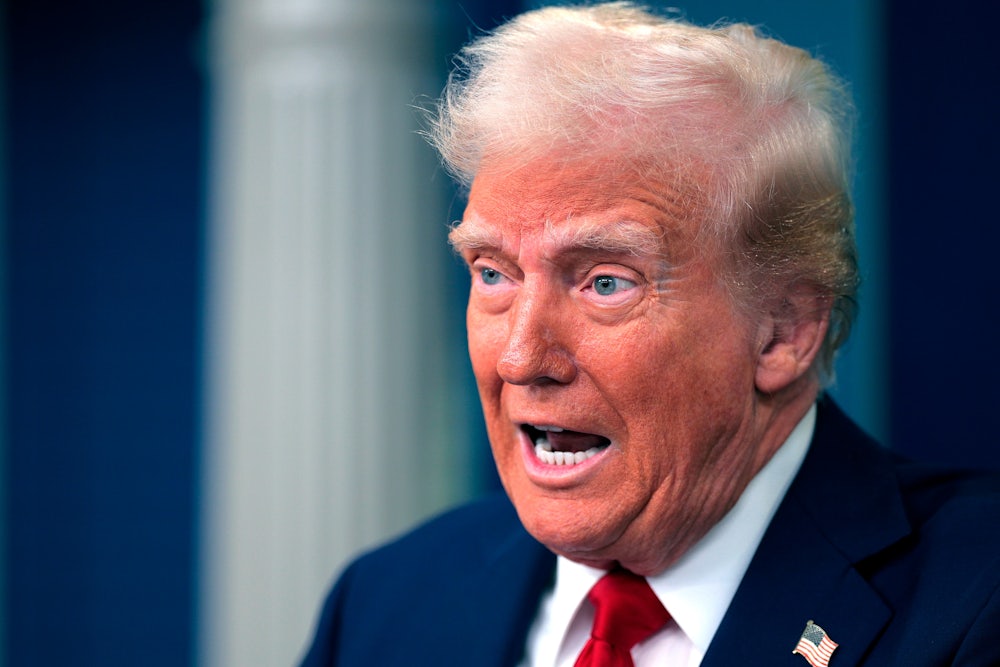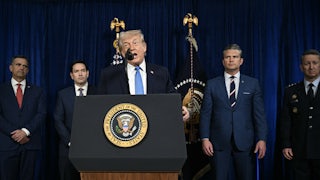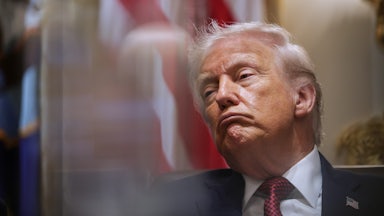Illegal border crossings are an emergency. The Mexican cartels are an emergency. Failure to expedite mining and drilling on federal lands is an emergency. Illicit drugs coming in from Canada, China, and Mexico are an emergency (actually, three). The International Criminal Court is an emergency. The trade deficit is an emergency. Brazil’s prosecution of its former president, Jair Bolsonaro, is an emergency. Crime in Washington, D.C., is an emergency. Crime in Chicago and Baltimore may soon be emergencies too. “We’re going in,” President Donald Trump said Tuesday. “I didn’t say when.”
Trump has declared nine national emergencies under the 1976 National Emergencies Act, or NEA, during the seven months he’s been in office. That’s 1.3 emergencies per month. If we include crime in D.C., which Trump declared an emergency under a different law—the 1973 Home Rule Act—it’s an even 10. For now. “We may declare a national housing emergency in the fall,” Treasury Secretary Scott Bessent told the Washington Examiner on Monday. That’s 11. Add Chicago and Baltimore, and it’s 13, assuming Trump doesn’t dream up more emergencies to declare in the interim.
During his first term it took Trump four long years to declare 13 emergencies, and some of them were actually real (most notably, Covid-19). Once a president declares a national emergency he may help himself to 137 different statutory powers, according to the nonprofit Brennan Center for Justice, which lists them here. It’s obvious Trump covets these.
Trump’s excessive use of emergency powers is itself an emergency. The best solution would be a definition explaining what “emergency” means under the NEA; the statute doesn’t furnish one. Mark Medish, writing in The New Republic in 2022, noted that legislation to curb presidential emergency powers then enjoyed bipartisan support and that Trump’s first term had demonstrated why it was so urgently needed. Fix the roof, Medish warned, while the sun is still shining. But Congress did not act, and now it’s raining cats and dogs and we’ve got pots out everywhere to catch the leaks.
Trump’s phony emergencies aren’t confined to formal declarations. “You could say Trump has declared 10 emergencies,” the Brennan Center’s Elizabeth Goitein told me, “or you could say he has declared far more.”
An invasion, for example, sure sounds like an emergency, and Trump claims one along the southern border, Goitein pointed out, under the 1798 Alien Enemies Act so he can deport undocumented immigrants without the usual due process. In April, the Supreme Court said it was fine with that.
The phrase “national security” sounds emergency-like too, and in a March executive order and again last Thursday, Trump used vague national security language in the 1978 Civil Service Reform Act to justify voiding (or barring establishment of) collective bargaining rights at all or part of two dozen federal agencies. These vital military command posts include the Bureau of Land Management, the National Science Foundation, and the National Weather Service.
Georgetown labor historian Joe McCartin pronounced the mass union-contract nullifications “by far the largest single action of union busting in American history,” and he wasn’t wrong. Perhaps you thought it was a big deal when President Ronald Reagan fired 11,000 PATCO flight controllers way back in 1981. But in August alone, as The New York Times reported on Labor Day, Trump’s actions stripped protections from more than 445,000 federal workers. Harold Meyerson of The American Prospect put the total at more than one million federal workers—which, he noted, equals an astonishing one-fifteenth of all Americans covered by a union contract. In June, the American Federation of Government Employees won a preliminary injunction against the nullifications in district court, but that was later stayed by the Ninth Circuit while it reviews the case.
The only area where Trump is reluctant to declare emergencies is in the granting of disaster assistance, under the 1974 Robert T. Stafford Disaster Relief and Emergency Assistance Act, to states struggling to recover from floods, tornadoes, wildfires, and the like. Even as Trump makes up fake emergencies, he blows off real ones! Trump actually proposed eliminating the Federal Emergency Management Agency, which administers disaster funds. That’s no longer on the table, but under Trump the FEMA response has been notably slower and stingier than in the past.
An exasperating barrier to fighting the emergency emergency is the absence of any obvious legal strategy to halt Trump’s overuse of emergency declarations. “I don’t know any way to bring a legal challenge to the heavy reliance on emergency powers,” Goitein told me, and if she doesn’t know I doubt anybody else does. Impeachment may offer freer rein, but we’re a long way from that. So lawyers are stuck with challenging individual abuses in court as they arise.
Actually, Goitein had one idea. She suggested that judges start granting less deference to the executive branch. She noted that in Sterling v. Constantin (1932) and Baker v. Carr (1962) the high court suggested circumstances under which presidents should be granted less than the usual deference. In Sterling, the high court made reference to “a permitted range of honest judgment,” implying bad faith would lie outside that range. One difficulty, though, is that Sterling concerned executive power wielded at the state rather than federal level.
Some judges have indeed started saying to the Trump administration, in effect, Cut the shit. “Blind deference to the government?” said Judge Zia M. Faraqui recently, when asked by federal prosecutors not to unseal a search warrant. “That is no longer a thing.” At a hearing concerning Kilmar Ábrego Garcia, whom the Trump administration deported to El Salvador in defiance of her court ruling, Judge Paula Xinis tried and failed to get a straight answer from prosecutors about what they’d do with Garcia once he was brought back. “This has been the process from Day One,” she erupted. “You have taken the presumption of regularity and you’ve destroyed it in my view.”
If Trump keeps declaring emergencies—and, of course, he will—the best response may be for protesters to create an emergency of their own through the expansion of nonviolent public protest. We’ve had May Day and No Kings Day and Good Trouble Lives and Workers Over Billionaires. How about Cut the Shit Day?
In August, the nonprofit Center for American Progress suggested, based on research by Harvard political scientist Erica Chenoweth and others, that it will take about 12 million Americans—a mere 3.5 percent of the population—to halt Trump’s abuses of power. This can happen. In March, I published a guide to resisting Trump. I’m no expert on this subject, but I consulted a lot of people who are, and they had some good ideas. We may need to try all of them, because the emergency emergency won’t end itself. We’re already seeing considerable mass protest. Let’s build on that.






